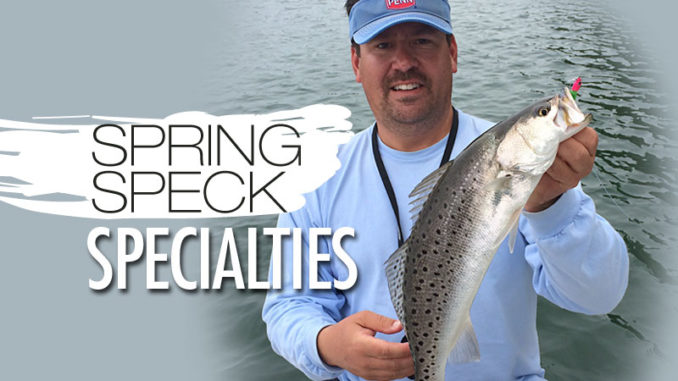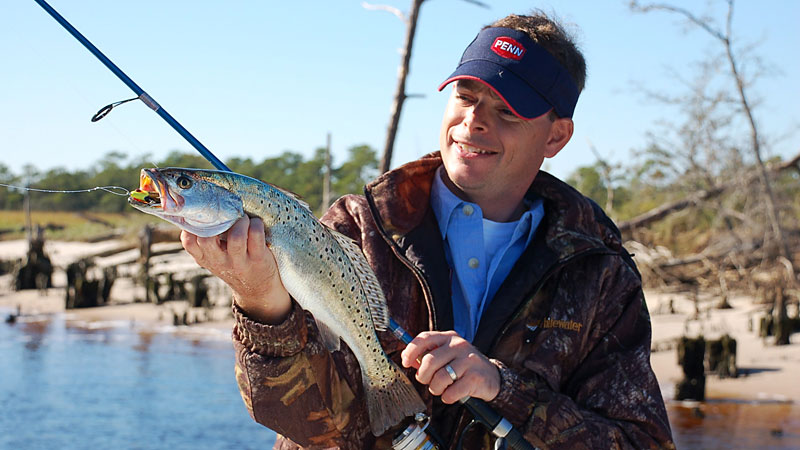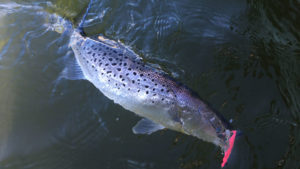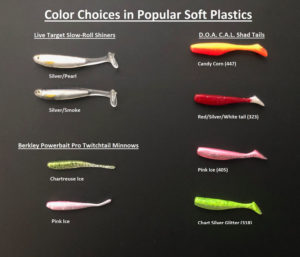
Speckled trout bite shifts into high gear
The spring thaw brings outdoorsmen out of hiding, into the woods for a long-bearded turkey dinner or onto the water for one of their finned favorites. For anglers with saltwater running through their veins, the springtime speckled trout bite is hard to avoid. But certain lures will bring more fish to the boat than others.
In the Carolinas, speckled trout are available year-round. But the spring and fall bites are significantly better than the winter and summer. Speckled trout are feisty feeders much of the year. And when the water temperature begins to trend upwards in spring, feeding activity shifts into another gear.
The menu changes for speckled trout and other inshore fishes on a monthly basis. From shrimp, menhaden and finger mullet to croakers, pinfish and other juvenile fish, the variety of groceries changes seasonally due to availability. Specks are going to eat. But what they eat in April may not be what they eat in July. For anglers, lure choice can be a critical component to the equation if you don’t fish with bait.
Spring conditions in the Carolinas can change from chilly, near-freezing nightly temperatures to sweltering heat. Fortunately, water temperatures don’t fluctuate as quickly as the air temperatures. And water temperatures trend upward all spring.

Match the hatch for spring speckled trout
Jot Owens of Wrightsville Beach, N.C., guides in the waters around Cape Fear. Specks are one of his coveted species he targets year-round. Owens’ strategy in spring changes mid-season between periods of cool weather coming off the winter to a steady warming trend pushing toward summer.
“When the water temperature is below 60 degrees in the spring, no shrimp are around. And trout are eating small spots, croakers, pinfish, killifish, silversides and other baitfish,” said Owens (910-233-4139). “These smaller baits are thick and provide a steady diet for trout and other gamefish through late winter and into early spring.”
On the winter side of the warmup, trout are making a living on the available baitfish living in creeks and near inlets. In early spring, when water temperatures remain low, Owens targets trout with lures that imitate baits common in their environments for that time period.
Small stands tall
“When the water temperatures remains below 60 degrees, the larger baitfish are few and far between. That makes smaller lures better than larger baits. We get better numbers of fish and bigger fish too,” he said. “My top two soft plastics are 3-inch Powerbait Pro Twitchtail Minnows and 3-inch Powerbait Ca$h Out Worm. Both have small profiles that mimic the available bait this time of year.”
These small-profile soft plastics rigged on 1/16- to 1/8-ounce jigheads are the way to go in early spring conditions. The light jigheads and small-profile lures produce a slow fall.

“The slow sink, even in deep water, will get these slow fish to bite,” Owens said.
As spring conditions arrive with more warm days, the water temperature will trend upward into the 60s consistently. Larger-sized baitfish become more available, and larger baits can produce more consistent bites.
“When water temperatures consistently stay in the 60s for a few weeks, larger baitfish patterns and techniques become relevant and produce good returns,” he said.
Not only do larger baits become available, the activity level of both trout and baitfish increases. And that opens the door to more aggressive techniques.
Warm temps mean topwater, bigger soft plastics
“We start off the day throwing Top Dog Jrs. along the grass lines, creek mouths and around oyster bars,” he said. “And after the topwater bite slows down — or if it never materializes — we switch to other hard baits that run just below the surface, like a MirrOdine or Catch 2000.”
Small menhaden often show up, offering trout and other gamefish a steady diet. Small, suspending hard baits such as the MirrOdine 17MR mimic the small menhaden and other 3- to 4-inch baitfish. And the suspending versions give trout an opportunity to take the bait without having to break the surface.
Even as the water temperature rises into the 60s, soft plastics will remain part of Owens’ arsenal. Trout become more aggressive with the warmer water and will take larger lures, such as a 5-inch jerk shad and 4-inch artificial shrimp.
Lure choice and tactics during spring in the Carolinas can vary tremendously but can be easily dictated by the water temperature and the visible forage in the area.
“Trout are eating what is available to them throughout the year,” Owens said. “Look and observe the bait you see in the water this time of year, and it will tell you what types and what sizes of lures that you need to use,” he said.
Choice of lures, colors dictates speckled success
Successful anglers who favor artificial lures will use a huge selection of colors throughout the year. With countless color combinations from which to choose, how does an angler decide which to select to dupe their prey?

At some point, fish have been caught on almost every color produced. But some will undoubtedly produce more fish than others under certain conditions and in specific locations. Some shapes and colors exactly mimic actual baitfish. For instance, Live Target’s Slow-Roll Shiner in silver/smoke looks exactly like a small silverside. While these soft plastics will be readily eaten by trout and other predators, sometimes a lure in a completely unnatural color will get more attention.
One of the most-popular lure colors for trout in the Carolinas is chartreuse. In some circumstances, a lure with a tail tipped in chartreuse or fully chartreuse lure will beat down a natural-colored lure all-day long.
Choices, choices
Anglers can be swayed towards one color category or the other, depending on water clarity and water conditions. Guide Jot Owens of Wrightsville Beach, N.C., said color choice varies for him depending on whether he’s fishing in clear, ocean water or stained, river or creek waters.
“In the ocean, I prefer brighter colors — chartreuse, pink, pearl white — and even some natural colorations when I have clear conditions,” Owens said. “In stained waters, I will switch to darker colors, such as new penny, swamp gas and motor oil.”
No doubt, color choices can make a difference, especially when fishing inshore waters for specks, because they are sight-feeders. Trout rely strictly on their eyesight to obtain their next meal. Different colors can make a passing bait stick out and grab their attention. Sometimes that is the natural blending in color, and other times it may be the gaudiest-looking color ever created.
Anglers need to experiment with different colors and lure combinations to get the job done.





Be the first to comment